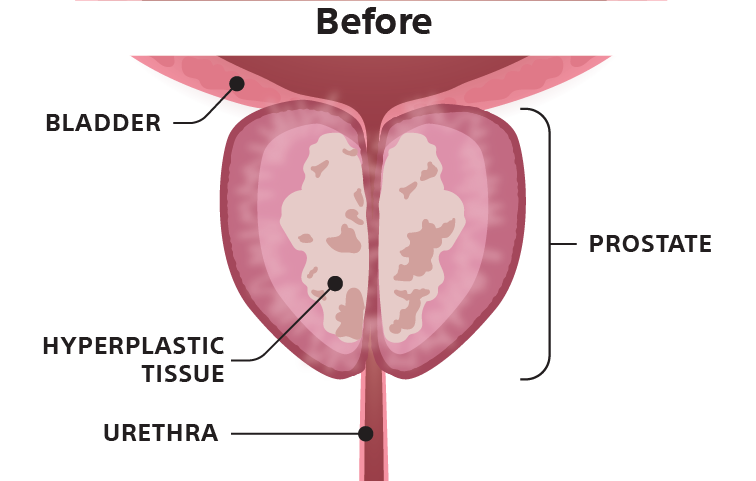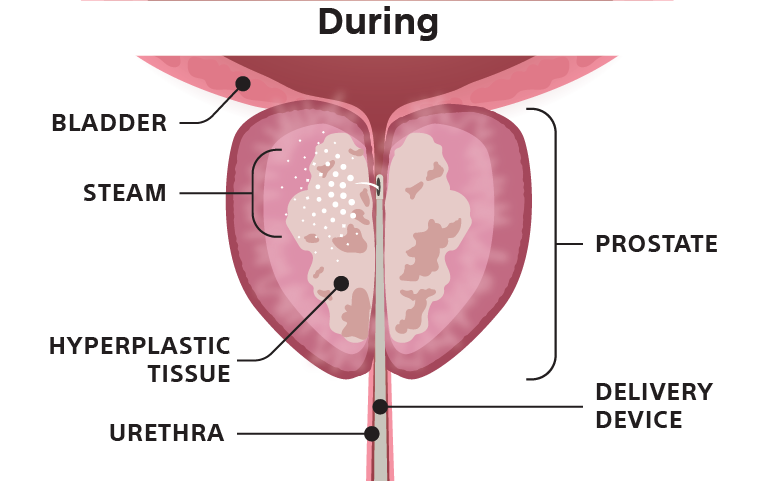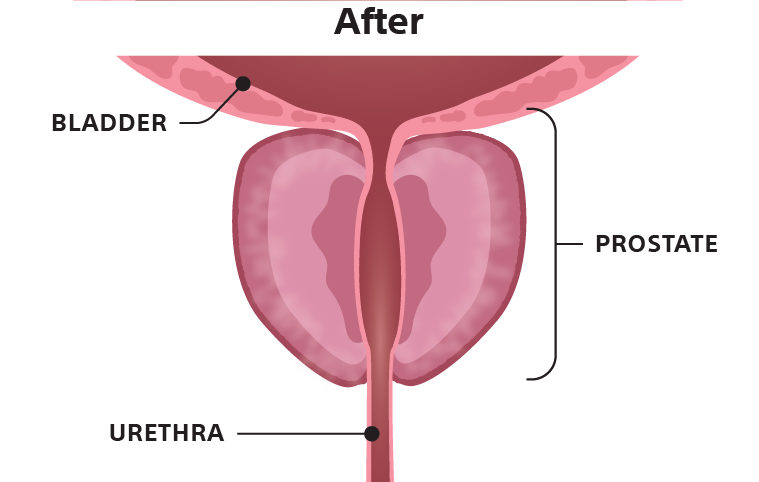
Get Information About Catheterization with Rezūm™ Water Vapor Therapy
You might have heard that after some treatments for BPH, you need a catheter during your recovery. That can sound intimidating, but it’s an important part of the healing process.
All BPH Articles / BPH Treatment Options / Get Information About Catheterization with Rezūm™ Water Vapor Therapy
An enlarged prostate, or benign prostatic hyperplasia (BPH), can be a long-term condition — and men deserve a long-term solution.
That’s why doctors and patients choose to treat BPH with Rezūm Therapy, an in-office treatment for men 50 years or older that uses the natural energy in water vapor to reduce the size of your prostate. Learn more about Rezūm Therapy.
Every BPH therapy has its pros and cons. Minimally invasive treatments like Rezūm Therapy are an alternative to surgery and medications, but one drawback is that your physician may recommend to be catheterized for a few days after the procedure.1,2 This may be an important part of your healing process — Rezūm Therapy, it’s because the source of your BPH is being treated.
Why is catheterization important?
Rezūm Therapy treats the source of BPH by reducing the tissue volume of the prostate and thus, improving the urinary symptoms of BPH. Post procedure, this treatment causes natural swelling while the body is healing, and that’s why catheterization can be needed to keep the urinary tract open until the swelling goes down. See how it works.
How to prepare for catheterization
It’s important to prepare for all aspects of your BPH procedure, including catheterization during recovery. You should know that wearing a catheter can cause discomfort, inconvenience and embarrassment and, although rare, trauma to the urethra and infection.3,4
Physicians work with their patients to decide the best treatment option and catheter for their needs. For example, during the day, you may use a leg bag to collect urine because it is less obtrusive than other types of bags and can be discreet, while at night you can use a larger bag. The key takeaway is that you and your doctor should be able to find an approach that works for you.
Setting expectations
Your doctor should help you understand what to expect from your procedure.
How long will you need a catheter after Rezūm Therapy? On average, men who had Rezūm Therapy had a catheter for 3 to 4 days after their procedure.7 The length of time a catheter is needed after Rezūm Therapy can vary by the physician, the technique, the size of the prostate gland, and the patient. Your doctor should be able to give you an estimate on how long you may need a catheter. And before your catheter is removed, your doctor will make sure that you are able to urinate properly.*
Remember, becasue the tissue is being denatured by the injections, your body needs time to heal.* The catheter can allow it to do so.
Here are some other things to expect when it comes to Rezūm Therapy:
- Catheters may cause infection so your physician may recommend things like drinking a lot of water and using the catheter correctly.2
- Recovery experience may be longer than other minimally invasive therapies because Rezūm Therapy is treating the source of BPH.10 One purpose of the catheter is to help you remain comfortable while still healing and returning to regular activities within a few days after the catheter is removed.*7
- There is no clinically meaningful impact to erectile or ejaculatory function with Rezūm Water Vapor Therapy.9
- Rezūm Therapy provides lasting relief, including a lower chance of needing another surgery to retreat BPH — an advantage over other minimally invasive procedures.**5,8
The recommended approach to treating BPH is to understand your condition, your treatment options, and how to prepare for your chosen therapy. When it comes to Rezūm Therapy, consider the pros and cons of having a catheter, as well as how Rezūm Therapy provides lasting relief and long-term symptom relief.5 Being well-prepared can give you reasonable expectations for your BPH treatment, and confidence in your choice with Rezūm Therapy.
Most patients report relatively minor discomfort during the Rezūm procedure. Potential risks associated with Rezūm Water Vapor Therapy include but are not limited to painful or frequent urination, blood in the urine or semen, decrease in ejaculatory volume, urinary tract infection (UTI), inability to urinate or completely empty the bladder, and urgent need to urinate. During healing, symptoms may continue or worsen. Most men require a catheter for several days post-procedure.13,15 A complete list of risk information can be found here.
![]()
Find a Doctor
Use our Doctor Finder to get in direct contact with urologists who specialize in using Rezūm Water Vapor Therapy to treat BPH.
References
- Baboudjian M, Fourmarier M, Gondran-Tellier B, et al. Head-to-head comparison of prostatic urethral lift and water vapor thermal therapy for the treatment of symptomatic benign prostatic hyperplasia: a real-life study. Int Urol Nephrol. 2021 Sep;53(9):1757–63.
- Cafasso J. Urinary Catheters: Uses, Types, and Complications. Healthline. https://www.healthline.com/health/urinary-catheters. Accessed June 21, 2022.
- Oswald F, Young E, Denison F, et al. Staff and patient perceptions of a community urinary catheter service. Int J Urol Nurs. 2020;14(2):83–91.
- Willette PA, Coffield S. Current trends in the management of difficult urinary catheterizations. West J Emerg Med. 2012 Dec;13(6):472–8.
- McVary KT, Gittelman MC, Goldberg KA, et al. Final 5-year outcomes of the multicenter randomized sham-controlled trial of Rezūm water vapor thermal therapy for treatment of moderate-to-severe lower urinary tract symptoms secondary to benign prostatic hyperplasia. J Urol. 2021 Sep;206(3):715–24.
- Leong JY, Tokarski AT, Roehrborn CG, Das, AK. UroLift and Rezūm: minimally invasive surgical therapies for the management of benign prostatic hyperplasia. Can J Urol. 2021 Aug;28(S2):2–5.
- McVary KT, Gange SN, Gittelman MC, et al. Minimally invasive prostate convective water vapor energy ablation: A multicenter, randomized, controlled study for the treatment of lower urinary tract symptoms secondary to benign prostatic hyperplasia. J Urol. 2016 May;195(5):1529–38.
- Roehrborn CG, Barkin J, Gange SN, et al. Five-year results of the prospective randomized controlled prostatic urethral L.I.F.T. study. Can J Urol. 2017 Jun;24(3):8802–13.
- McVary KT, El‐Arabi A, Roehrborn C. Preservation of Sexual Function 5 Years After Water Vapor Thermal Therapy for Benign Prostatic Hyperplasia. Sex Med. 2021 Oct 30;9(6):100454.
- Tutrone RF, Schiff W. Early patient experience following treatment with the UroLift prostatic urethral lift and Rezum steam injection. Can J Urol. 2020 Jun;27(3):10213–10219. PMID: 32544043.
*Dependent on individual clinical situation and healing response.
**Results from different clinical investigations are not directly comparable.
Christopher Cantrill, MD, is a Boston Scientific consultant and was compensated for his contribution to this article. All images are the property of Boston Scientific. All trademarks are the property of their respective owners.
Bilal Chughtai, MD, is a Boston Scientific consultant and was compensated for his contribution to this article. All images are the property of Boston Scientific. All trademarks are the property of their respective owners.
Amy Pearlman, MD, is a Boston Scientific consultant and was compensated for his contribution to this article. All images are the property of Boston Scientific. All trademarks are the property of their respective owners.
Caution: U.S. Federal law restricts this device to sale by or on the order of a physician.
Content on this web page is for Informational Purposes only and does not constitute medical advice and should not be used for medical diagnoses. Boston Scientific strongly recommends that you consult with your physician on all matters pertaining to your health or to address any clinical/medical questions.
All images are the property of Boston Scientific. All trademarks are the property of their respective owners.
Rezum.com is a website sponsored by Boston Scientific.






